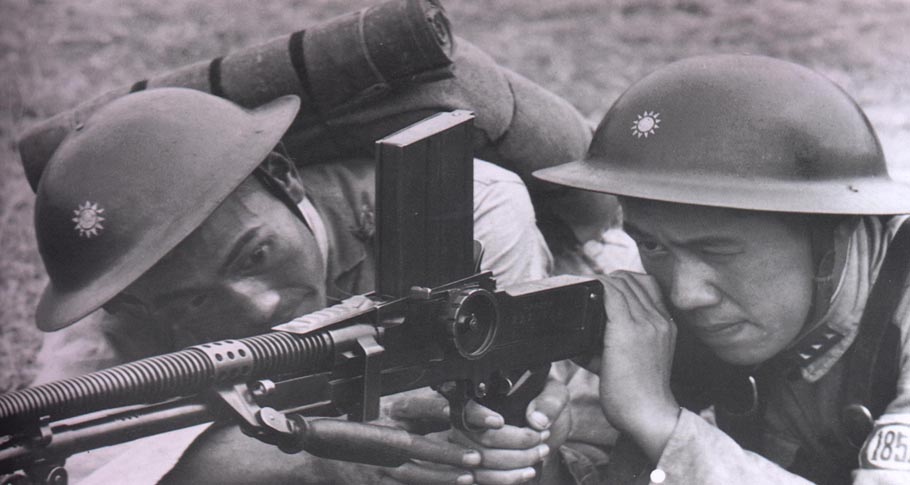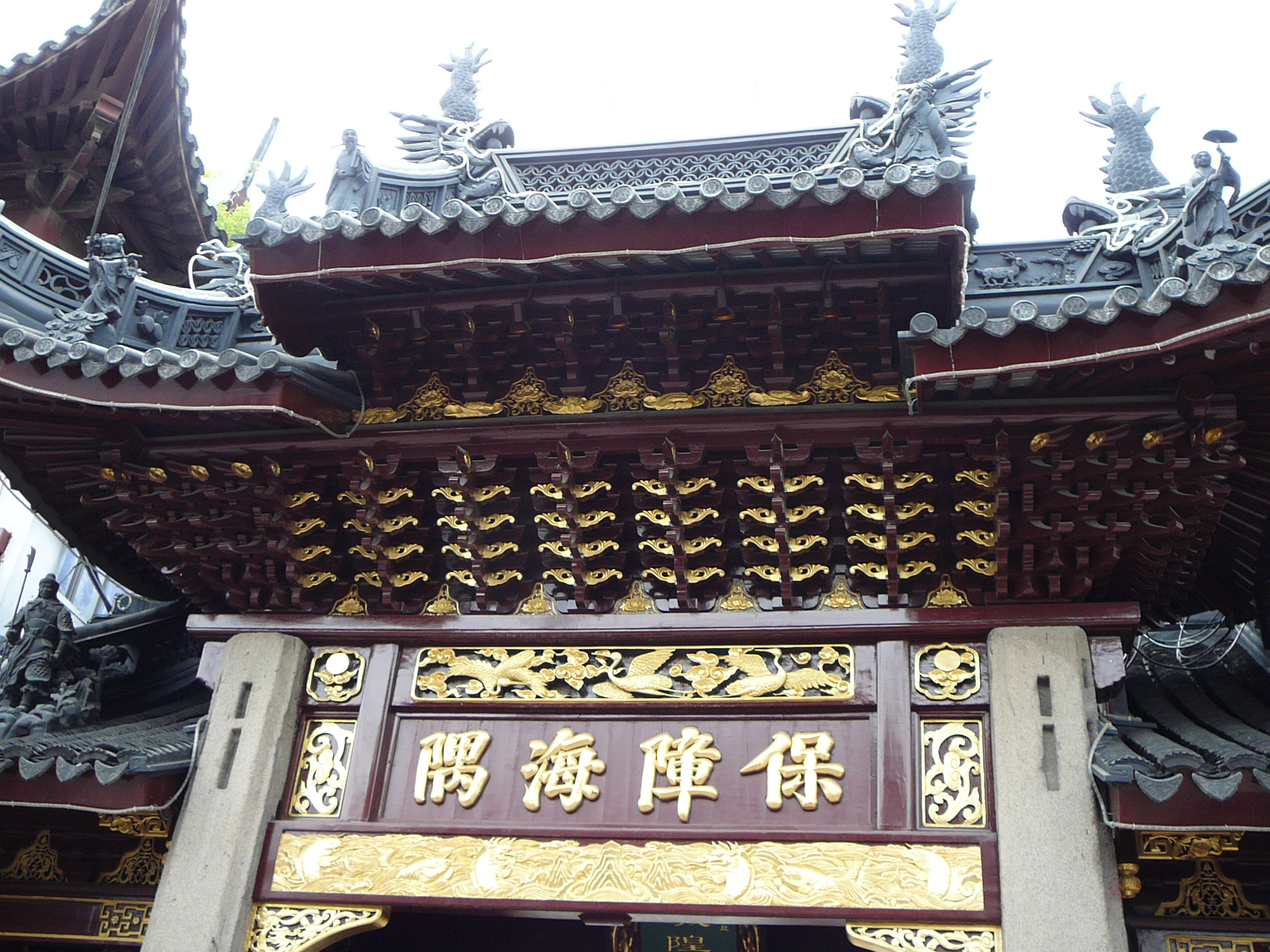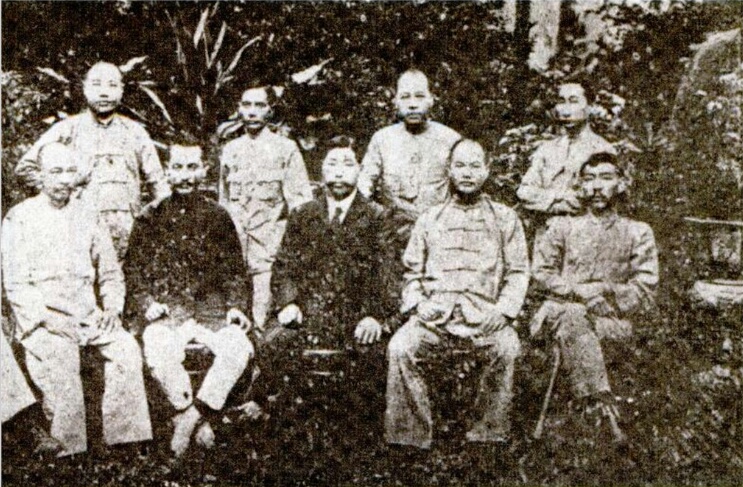|
National Revolutionary Martyrs' Shrine
The National Revolutionary Martyrs' Shrine () is a shrine in Zhongshan District, Taipei, Taiwan, dedicated to the war dead of the Republic of China. Built on Chingshan Mountain and overseeing the Keelung River in Taipei's Zhongshan District in 1969, the Martyrs' Shrine recalls the architecture of the Hall of Supreme Harmony in Beijing's Forbidden City. The structure houses the spirit tablets of about 390,000 persons killed, among other engagements, during the Xinhai Revolution, Northern Expedition, Second Sino-Japanese War, Chinese Civil War, and the First and Second Taiwan Strait Crises. A changing of the honor guard from the various branches of the Republic of China Military, similar to the rituals at the Sun Yat-sen Memorial Hall and Chiang Kai-shek Memorial Hall, take place at the shrine. The Martyrs' Shrine was the site of the funeral of Chiang Ching-kuo in 1988. On March 29 (Youth Day, commemorating the Huanghuagang Uprising) and September 3 (Armed Forces Day) of ev ... [...More Info...] [...Related Items...] OR: [Wikipedia] [Google] [Baidu] |
Republic Of China
Taiwan, officially the Republic of China (ROC), is a country in East Asia, at the junction of the East and South China Seas in the northwestern Pacific Ocean, with the People's Republic of China (PRC) to the northwest, Japan to the northeast, and the Philippines to the south. The territories controlled by the ROC consist of 168 islands, with a combined area of . The main island of Taiwan, also known as ''Formosa'', has an area of , with mountain ranges dominating the eastern two-thirds and plains in the western third, where its highly urbanised population is concentrated. The capital, Taipei, forms along with New Taipei City and Keelung the largest metropolitan area of Taiwan. Other major cities include Taoyuan, Taichung, Tainan, and Kaohsiung. With around 23.9 million inhabitants, Taiwan is among the most densely populated countries in the world. Taiwan has been settled for at least 25,000 years. Ancestors of Taiwanese indigenous peoples settled the island around 6,00 ... [...More Info...] [...Related Items...] OR: [Wikipedia] [Google] [Baidu] |
Republic Of China Military
The Republic of China Armed Forces (ROC Armed Forces) are the armed forces of the Republic of China (ROC), once based in mainland China and currently in its remaining jurisdictions which include the islands of Taiwan, Penghu, Kinmen, Matsu, and other smaller ROC-controlled islands such as Taiping Island in the South China Sea. They consist of the Army, Navy (including the Marine Corps), Air Force and Military Police Force. The military is under the civilian control of the Ministry of National Defense, a cabinet-level agency overseen by the Legislative Yuan. It was previously named the National Revolutionary Army (NRA) before being renamed as the Republic of China Armed Forces in 1947 due to the implementation of the newly promulgated Constitution of the Republic of China. It was also historically referred as the Chinese National Armed Forces (CNAF) prior to the establishment of the People's Republic of China on the Chinese mainland and the gradual loss of international r ... [...More Info...] [...Related Items...] OR: [Wikipedia] [Google] [Baidu] |
Kaohsiung Martyrs' Shrine
The Kaohsiung Martyrs' Shrine () is a Martyrs shrine, martyrs' shrine in Gushan District, Kaohsiung, Taiwan. History Empire of Japan The site was originally established as Takao Shrine, Takao Kotohira Shrine during the Taiwan under Japanese rule, Japanese rule of Taiwan in 1910 dedicated to Omononushi-no-Mikoto and Emperor Sutoku. In 1920, government of Takao Prefecture applied to the Taiwan Governor-General’s Office central government in Taihoku Prefecture for additional worshipping of Prince Yoshihisa and renamed the shrine as Takao Shrine.In 1926, upon acquisition of land on the hillside of Shoushan, fundraising was underway for the Shrine relocation, which was completed in 1929 and received the Kensha rank in 1932, officially listed in the Japanese state Shinto system. Republic of China In 1946 after the Retrocession Day, handover of Taiwan from Japan to the Republic of China, the shrine was slightly renovated to make it as a martyrs' shrine. In 1972, Japan Timeline of di ... [...More Info...] [...Related Items...] OR: [Wikipedia] [Google] [Baidu] |
Taipei Metro
Taipei Mass Rapid Transit (MRT), branded as Metro Taipei, is a rapid transit system serving the areas of Taipei and New Taipei City, New Taipei in Taiwan, operated by the State-owned enterprise, government-owned Taipei Rapid Transit Corporation, which also operates the Maokong Gondola. Taipei Metro was the first metro system ever built in Taiwan. The initial network was approved for construction in 1986 and work began two years later. It began operations on March 28, 1996, and by 2000, 62 stations were in service across three main lines. Over the next nine years, the number of passengers had increased by 70%. Since 2008, the network has expanded to 131 stations and the passenger count has grown by another 66%. The system has been praised by locals for its effectiveness in relieving growing traffic congestion in Taipei and its surrounding satellite towns, with over two million trips made daily. History Proposal and construction The idea of constructing the Taipei Metro was fir ... [...More Info...] [...Related Items...] OR: [Wikipedia] [Google] [Baidu] |
Dazhi Station
The Taipei Metro Dazhi station is located in the Zhongshan District in Taipei, Taiwan. It is a station of Brown Line. Station overview This two-level, underground station features an island platform, three exits, and a platform elevator located on the south side of the concourse level. This station, along with station, are the only two underground stations on the Wenhu line. They are also the first underground stations in the system to have platform doors. The platform level is 159 meters long, while the platform itself is long and wide. The theme for this station is "Landscape". History *23 May 2002: Construction begins on Dazhi station. *28 April 2008: Construction is completed. *4 July 2009: Begins service with opening of Brown Line. Station layout Exits *Exit 1: Da-zhi St. (Da-zhi Community) *Exit 2: Intersection of Bei-an and Da-zhi St. *Exit 3: Intersection of Bei-an and Da-zhi St. Around the stations * Dajia Riverside Park * National Revolutionary Martyrs' Sh ... [...More Info...] [...Related Items...] OR: [Wikipedia] [Google] [Baidu] |
Paifang
A ''paifang'', also known as a ''pailou'', is a traditional style of Chinese architectural arch or gateway structure. Evolved from the Indian subcontinent's ''torana'' through the introduction of Buddhism to China, it has developed many styles and has been introduced to other East Asian countries, such as Korea, Japan, and Vietnam. Etymology The word ''paifang'' () was originally a collective term for the top two levels of administrative division and subdivisions of ancient Chinese cities. The largest division within a city in ancient China was a ''fang'' (), equivalent to a current day ward. Each ''fang'' was enclosed by walls or fences, and the gates of these enclosures were shut and guarded every night. Each ''fang'' was further divided into several ''pai'' (), which is equivalent to a current day (unincorporated) community. Each ''pai'', in turn, contained an area including several hutongs (alleyways). This system of urban administrative division and subdivision reached an ... [...More Info...] [...Related Items...] OR: [Wikipedia] [Google] [Baidu] |
Typhoon Nora (1973)
Typhoon Nora, known in the Philippines as Typhoon Luming, was the fourth-most intense tropical cyclone on record. Originating from an area of low pressure over the western Pacific, Nora was first identified as a tropical depression on October 2, 1973. Tracking generally westward, the system gradually intensified, attaining typhoon status the following evening. After turning northwestward, the typhoon underwent a period of rapid intensification, during which its central pressure decreased by 77 Bar (unit), mb (Pascal (unit), hPa; 2.27 Inches of Mercury, inHg) in 24 hours. At the end of this phase, Nora peaked with winds of and a pressure of 875 mb (hPa; 25.91 inHg), making it the most-intense tropical cyclone on record (alongside Typhoon Ida (1958), Typhoon Ida in 1958) at the time; however, this pressure has since been surpassed by Typhoon June (1975), Typhoon June, Typhoon Tip and Hurricane Patricia. The typhoon subsequently weakened and turned nort ... [...More Info...] [...Related Items...] OR: [Wikipedia] [Google] [Baidu] |
2003 SARS Outbreak
3 (three) is a number, numeral and digit. It is the natural number following 2 and preceding 4, and is the smallest odd prime number and the only prime preceding a square number. It has religious or cultural significance in many societies. Evolution of the Arabic digit The use of three lines to denote the number 3 occurred in many writing systems, including some (like Roman and Chinese numerals) that are still in use. That was also the original representation of 3 in the Brahmic (Indian) numerical notation, its earliest forms aligned vertically. However, during the Gupta Empire the sign was modified by the addition of a curve on each line. The Nāgarī script rotated the lines clockwise, so they appeared horizontally, and ended each line with a short downward stroke on the right. In cursive script, the three strokes were eventually connected to form a glyph resembling a with an additional stroke at the bottom: ३. The Indian digits spread to the Caliphate in the 9th ... [...More Info...] [...Related Items...] OR: [Wikipedia] [Google] [Baidu] |
Taiwan McDonald's Bombings
The Taiwan McDonald's bombings () occurred on April 28 and 29, 1992. Bombs were planted in or near various McDonald's restaurant franchises in Taiwan. The bombings – part of an extortion attempt – caused the death of a policeman and injuries to four civilians, including two young children, and resulted in the temporary closure of certain McDonald's locations in Taiwan. Two people were subsequently convicted of involvement in the bombings, with the bomber themselves being sentenced to life imprisonment. Bombings The first bomb exploded at a restaurant in Taipei on the afternoon of April 28, 1992. A device had been located in the male toilets in the restaurant and the bomb squad were in attendance at the time. The bomb went off as it was either being removed from the restaurant or as an attempt was being made to defuse it in situ. The resulting explosion killed one bomb squad officer. Later that day another bomb exploded in a telephone booth outside a McDonald's in Kaohsiung in ... [...More Info...] [...Related Items...] OR: [Wikipedia] [Google] [Baidu] |
Taiwanese Imperial Japan Serviceman
A Taiwanese Imperial Japan Serviceman () is any Taiwanese person who served in the Imperial Japanese Army or Navy during World War II whether as a soldier, a sailor, or in another non-combat capacity. According to statistics provided by Japan's Ministry of Health, Labour and Welfare, during the Second Sino-Japanese War and the subsequent World War II, a total of 207,183 Taiwanese served in the military of Imperial Japan and 30,304 of them were declared killed or missing in action. History Starting in July 1937, Taiwanese began to play a role on the battlefield, initially as civilian interpreters, transporters, laborers, and other noncombatant positions. Prior to this, the Taiwanese were banned from serving in the Japanese military. Taiwanese people were not recruited for combat until late in the war due to Japanese suspicions of Taiwanese loyalty. However some Taiwanese were needed as translators for operations in China. After the United States entered the war in 1942, the Spe ... [...More Info...] [...Related Items...] OR: [Wikipedia] [Google] [Baidu] |
President Of The Republic Of China
The president of the Republic of China, now often referred to as the president of Taiwan, is the head of state of the Republic of China (ROC), as well as the commander-in-chief of the Republic of China Armed Forces. The position once had authority of ruling over Mainland China, but its remaining jurisdictions has been limited to Taiwan, Penghu, Kinmen, Matsu and other smaller islands since the conclusion of Second Chinese Civil War. Originally elected by the National Assembly, the presidency was intended to be a ceremonial office with no real executive power as the ROC was originally envisioned as a parliamentary republic. Since the 1996 presidential election, the president is directly elected by plurality voting to a four-year term, with incumbents limited to serving two terms. The incumbent, Tsai Ing-wen, succeeded Ma Ying-jeou on May 20, 2016, to become the first female president in the history of Taiwan. Qualifications * The ''Presidential and Vice Presidential Ele ... [...More Info...] [...Related Items...] OR: [Wikipedia] [Google] [Baidu] |
Huanghuagang Uprising
The Second Guangzhou (Canton) Uprising, known in Chinese as the Yellow Flower Mound Uprising or the Guangzhou Xinhai Uprising, was a failed uprising took place in China led by Huang Xing and his fellow revolutionaries against the Qing dynasty in Canton (Guangzhou). It is honored in Guangzhou's Yellow Flower Mound or Huanghuagang Park. History At this time Malaya, which included what is now Peninsular Malaysia and Singapore, had the largest Overseas Chinese population outside of China itself. Many of them were rich and carried out activities for the revolutionaries. On November 13, 1910, Sun Yat-sen, along with several leading figures of the Tongmenghui, gathered at the Penang conference to draw up plans for a decisive battle. The following day on November 14, 1910, Sun Yat-sen chaired an Emergency Meeting of the Tongmenghui at 120 Armenian Street (now the Sun Yat-sen Museum Penang) and raised Straits Dollars $8,000 on the spot. The planning events are known as the 1910 ... [...More Info...] [...Related Items...] OR: [Wikipedia] [Google] [Baidu] |




